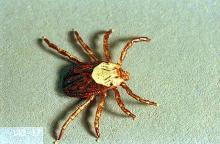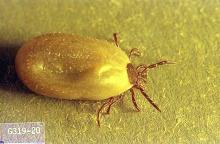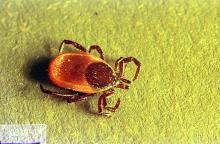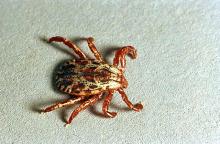1. Ixodid (hard-bodied) tick
Includes Dermacentor spp., and Ixodes spp.
Pest description and damage Rocky Mountain wood tick (Dermacentor andersoni) is one of the most important species. Found in eastern Oregon, it can transmit Colorado tick fever, Rocky Mountain spotted fever, and tularemia. Ixodes pacificus and Dermacentor occidentalis are the two species most commonly found on humans in western Oregon. I. pacificus is the main vector of Lyme disease in western Oregon.
Ticks are wingless, blood-sucking parasites about 0.2 inch long or smaller, and belong to the same class as spiders and mites. Their bodies are flat and usually a dark color. Adults and nymphs have four pair of legs, larvae only three.
2. Argasid (soft-bodied) tick
Omithodoros spp.
These soft ticks have been responsible for several human cases of tick-borne relapsing fever in the past several years in eastern Oregon. These ticks normally are found in the nests of small mammals and are primarily nocturnal.
Management
Prevention and control
Tick populations around dwellings can be reduced by removing habit of ticks and vertebrate hosts, especially rodents and deer. Remove brush and high vegetation, and mow lawns. Tuck pant legs into boots and shirts into trousers when walking in tick-infested areas. Use repellent on exposed body surfaces and on clothing. Repellents containing DEET (N,N-diethyl-meta-toluamide) are best. Use products with 30% DEET or less. Check clothing and body twice daily and remove ticks. Showering with soapy water after being in tick-infested areas will reduce likelihood of tick attachment. Tick management in the northeast and upper midwest United States is more critical: recommendations for tick management in the Northeast may be relevant where ticks are a problem elsewhere: http://www.ct.gov/caes/lib/caes/documents/publications/bulletins/b1010.pdf.
For further information:
Ticks. Washington State Department of Health. https://doh.wa.gov/community-and-environment/pests/ticks





